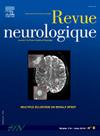French guidelines for the diagnosis and management of pure hereditary spastic paraplegia
IF 2.3
4区 医学
Q2 CLINICAL NEUROLOGY
引用次数: 0
Abstract
Introduction
Hereditary spastic paraplegia (HSP) describes a group of rare genetic neurological diseases characterized by a common clinical presentation made of progressive motor weakness and spasticity of the lower limbs. The global prevalence is estimated at 3.6 individuals per 100,000 inhabitants.
Clinical
The age of onset of first symptoms, the severity and the rate of progression are highly variable between different HSP subtypes, ranging from juvenile forms that present in the first years of life, to the later-onset forms, sometimes presenting after the age of 60. The medical history most often reveals an insidious onset of gait disturbances due to lower limb stiffness. The clinical examination reveals the key symptoms of HSP: pyramidal signs of the lower limbs with motor weakness predominantly involving the proximal muscles. As the condition progresses, moderate upper limb involvement as well as bladder and sphincter disorders may be present. When associated with other neurological or extra-neurological signs such as cerebellar ataxia, optic neuropathy, cardiomyopathy, or intellectual disability, HSP is referred to as “complex”. This is in contrast to the pure forms of HSP, where the pyramidal syndrome of the lower limbs occurs in isolation, which will be treated here.
Physiopathology
HSPs are a genetically heterogeneous group of disorders involving numerous distinct molecular pathways. However, regardless of the initial mechanism, they share a common pathophysiology characterized by primary first motor-neuron involvement. Lesions tend to predominate in the spinal cord, following a phenomenon of retrograde degeneration (“dying-back”) of the corticospinal tract.
Diagnosis and genetic counseling
The diagnostic approach will first aim to eliminate all non-genetic acquired forms of spastic paraplegia as well as other various differential diagnoses. More than 100 genes and disorders are grouped under the term HSP, with age of onset, disease progression and clinical presentation being highly variable. Pure forms of HSP are primarily inherited in an autosomal dominant or recessive manner. Genetic counseling for the patient and their family is ideally provided by a clinical geneticist once the precise molecular diagnosis has been obtained.
Management and care
The management of pure HSP is multidisciplinary. Its goal is to prevent complications and to propose symptomatic treatment at all stages of the disease. It is primarily based on motor rehabilitation through physiotherapy and physical activity. Psychological support should be offered from the moment the diagnosis is announced and throughout the follow-up. Multidisciplinary follow-up is coordinated by the primary care physician, in consultation with the expert pediatric neurologist/neurologist or neurogeneticist, and equally involves a physical medicine and rehabilitation physician and paramedical professionals (such as physiotherapists, social workers, occupational therapists, and psychologists).
法国纯遗传性痉挛性截瘫的诊断和治疗指南。
简介:遗传性痉挛性截瘫(HSP)描述了一组罕见的遗传性神经系统疾病,其常见的临床表现是进行性运动无力和下肢痉挛。全球流行率估计为每10万居民3.6人。临床:首次出现症状的年龄、严重程度和进展速度在不同的热休克亚型之间存在很大差异,从出现在生命最初几年的少年型到出现较晚的型,有时在60岁以后出现。医学史最常表现为下肢僵硬引起的步态障碍。临床检查显示HSP的主要症状:下肢锥体体征,主要累及近端肌肉的运动无力。随着病情的发展,可能出现中度上肢受累以及膀胱和括约肌紊乱。当伴有其他神经或神经外症状,如小脑性共济失调、视神经病变、心肌病或智力残疾时,HSP被称为“复杂”。这与单纯形式的HSP相反,后者的下肢锥体综合征是孤立发生的,这里将对其进行治疗。生理病理:热休克蛋白是一组遗传异质性的疾病,涉及许多不同的分子途径。然而,不管最初的机制如何,它们都有一个共同的病理生理特征,即主要的第一运动神经元参与。在脊髓皮质脊髓束出现逆行性退行性变(“死退”)后,病变往往主要发生在脊髓。诊断和遗传咨询:诊断方法将首先旨在消除所有非遗传获得形式的痉挛性截瘫以及其他各种鉴别诊断。100多种基因和疾病归为HSP一词,发病年龄、疾病进展和临床表现变化很大。纯HSP主要以常染色体显性或隐性方式遗传。一旦获得精确的分子诊断,临床遗传学家最好为患者及其家属提供遗传咨询。管理和护理:纯热休克蛋白的管理是多学科的。其目标是预防并发症,并在疾病的所有阶段提出对症治疗。它主要是基于通过物理治疗和身体活动的运动康复。心理支持应从宣布诊断的那一刻起直至整个随访期间提供。多学科随访由初级保健医生协调,与儿科神经科专家/神经科专家或神经遗传学家协商,同样涉及物理医学和康复医生以及辅助医疗专业人员(如物理治疗师、社会工作者、职业治疗师和心理学家)。
本文章由计算机程序翻译,如有差异,请以英文原文为准。
求助全文
约1分钟内获得全文
求助全文
来源期刊

Revue neurologique
医学-临床神经学
CiteScore
4.80
自引率
0.00%
发文量
598
审稿时长
55 days
期刊介绍:
The first issue of the Revue Neurologique, featuring an original article by Jean-Martin Charcot, was published on February 28th, 1893. Six years later, the French Society of Neurology (SFN) adopted this journal as its official publication in the year of its foundation, 1899.
The Revue Neurologique was published throughout the 20th century without interruption and is indexed in all international databases (including Current Contents, Pubmed, Scopus). Ten annual issues provide original peer-reviewed clinical and research articles, and review articles giving up-to-date insights in all areas of neurology. The Revue Neurologique also publishes guidelines and recommendations.
The Revue Neurologique publishes original articles, brief reports, general reviews, editorials, and letters to the editor as well as correspondence concerning articles previously published in the journal in the correspondence column.
 求助内容:
求助内容: 应助结果提醒方式:
应助结果提醒方式:


